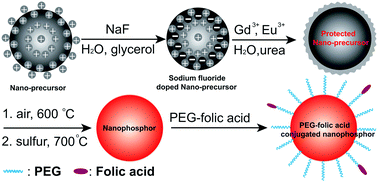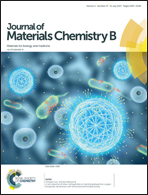Bright X-ray and up-conversion nanophosphors annealed using encapsulated sintering agents for bioimaging applications†
Abstract
Nanophosphors are promising contrast agents for deep tissue optical imaging applications because they can be excited by X-ray or near infrared light through tissue without background interference. For these bioimaging applications, the nanophosphors should ideally be small, monodispersed and brightly luminescent. However, most methods used to improve luminescence yield by annealing the particles to reduce crystal and surface defects (e.g. using flux or sintering agents) also cause particle fusion or require multiple component core–shell structures. Here, we report a novel method to prepare bright, uniformly sized X-ray nanophosphors (Gd2O2S:Eu or Tb) and upconversion nanophosphors (Y2O2S:Yb/Er, or Yb/Tm) with large crystal domain size without causing aggregation. A core–shell nanoparticle is formed, with NaF only in the core. We observe that increasing the NaF sintering agent concentration up to 7.6 mol% increases both crystal domain size and luminescence intensity (up to 40% of commercial microphosphors) without affecting the physical particle diameter. Above 7.6 mol%, particle fusion is observed. The annealing is insensitive to the cation (Na+ or K+) but varies strongly with anion, with F− > Cl− > CO32− > Br− > I−. The luminescence depends strongly on crystal domain size. The data agree reasonably well with a simple domain surface quenching model, although the size-dependence suggests additional quenching mechanisms within small domains. The prepared bright nanophosphors were subsequently functionalized with PEG–folic acid to target MCF-7 breast cancer cells which overexpress folic acid receptors. Both X-ray and upconversion nanophosphors provided low background and bright luminescence which was imaged through 1 cm chicken breast tissue at a low dose of nanophosphors 200 μL (0.1 mg mL−1). We anticipate these highly monodispersed and bright X-ray and upconversion nanophosphors will have significant potential for tumor targeted imaging.



 Please wait while we load your content...
Please wait while we load your content...